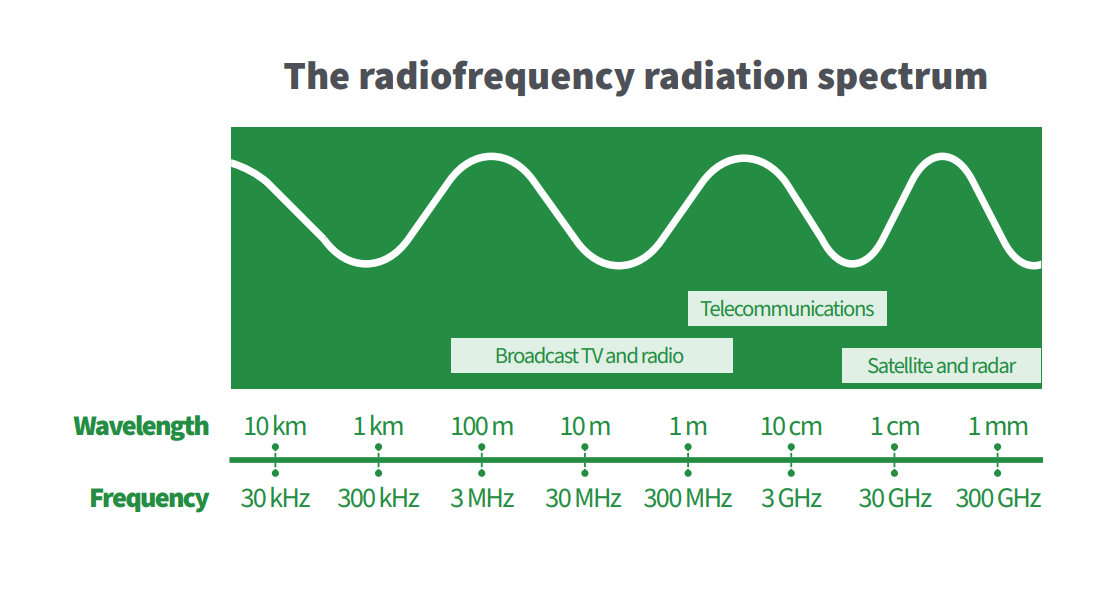Radiofrequency electromagnetic radiation carries energy and information.
What is radiofrequency radiation?
Radiofrequency (RF) electromagnetic radiation (EMR) is the transfer of energy by radio waves. RF EMR lies in the frequency range between 100 kilohertz (kHz) to 300 gigahertz (GHz). RF EMR is non-ionising radiation, meaning that it has insufficient energy to break chemical bonds or remove electrons (ionisation).

What are some sources of radiofrequency radiation?
RF EMR is produced by both natural and artificial sources. Natural sources like the sun, the earth and the ionosphere all emit low level RF fields. Artificial sources of RF EMR are mainly used for telecommunications purposes. Radio and television broadcasting, mobile phones, wireless networks such as Wi-Fi, cordless phones, police and fire department radios, point-to-point links and satellite communications all produce RF EMR. Other sources of RF fields include microwave ovens, radar, industrial heaters and sealers, and various medical applications.
How is radiofrequency radiation measured?
RF EMR has both electric and magnetic field components. It is often convenient to express the strength of the RF field in terms of each component. For example, the unit 'volts per metre' (V/m) is used to measure the electric field strength, and the unit 'amperes per metre' (A/m) is used to express the magnetic field strength. Another common way to characterise an RF field is by means of the power density. Power density is defined as power per unit area and is expressed in units of watts per square metre (W/m²) (or milliwatts per square centimetre, mW/cm², or microwatts per square centimetre, µW/cm²). The quantity used to measure how much RF EMR is actually absorbed by the body is called the Specific Absorption Rate or SAR. The SAR is usually expressed in units of watts per kilogram (W/kg) or milliwatts per gram (mW/g). The measurement of RF fields is described in detail in the Brooks Air Force Bases’s Radiofrequency Radiation Dosimetry Handbook.
More information about how RF EMR is measure can be found on our website.
How am I exposed to radiofrequency radiation?
Most RF fields found in the environment are due to commercial radio and TV broadcasting, and from telecommunications facilities (such as mobile phone base stations). RF exposure from telecommunications facilities is generally less than from radio or TV broadcasting. RF sources in the home include microwave ovens, mobile telephones, cordless telephones, wireless computer networks, smart meters, burglar alarms, and remote controls. Overall, the RF field background level from household appliances is low, and of the order of a few tens of µW/m². Relatively high levels of exposure to RF fields can occur to workers in the broadcasting, transport and communications industries when they work in close proximity to RF transmitting antennas and radar systems. Some industrial processes that use RF fields to heat materials can also produce high exposure to workers.
Exposure to RF reduces very rapidly with distance so although we may be exposed to RF from various sources (such as smart meters, mobile base stations and other wireless communication transmitters), it is close proximity to a particular source (e.g. when using a mobile phone) that will typically dominate the exposure. Measurement surveys have shown that exposure to RF radiation in the environment from various sources is very low and typically much lower than the allowable limit for safety in the Australian RF Standard.
What are the health effects of radiofrequency radiation exposure?
Exposure to sufficiently high levels of RF EMR can heat biological tissue and potentially cause tissue damage. The amount of environmental RF EMR routinely encountered by the general public is too low to produce significant heating or increased body temperature. At low levels of exposure to RF EMR (ie field intensities lower than those that would produce measurable heating) the evidence for production of harmful biological effects is ambiguous and unproven. Although there have been studies reporting a range of biological effects at low levels, there has been no indication that such effects might constitute a human health hazard. Some epidemiological studies have shown an association between heavy mobile and cordless phone use and brain cancer (most pronounced for glioma). Limitations of the methodology prevent conclusions of causality being drawn from these observations. The possibility of adverse health effects from the use of mobile phones is described in the ARPANSA fact sheet Mobile Telephones and Health.
How can I protect myself from RF exposure?
In 2021 ARPANSA published the standard: Standard for Limiting Exposure to Radiofrequency Fields – 100 kHz to 300 GHz. The ARPANSA RF Standard sets limits for human exposure to RF EMR in the frequency range 100 kHz to 300 GHz. The Standard also includes requirements for protection of the general public and the management of risk in occupational exposure, together with additional information on measurement and assessment of compliance.
In March 2014 an independent Expert Panel reviewed the scientific literature published since the ARPANSA RF Exposure Standard was prepared. The Expert Panel found that the exposure limits in the RF Standard continue to provide a high degree of protection against the known health effects of RF electromagnetic fields (Review of Radiofrequency health Effects Research - Scientific Literature 2000-2012 (arpansa.gov.au)).
Links
- The World Health Organization’s International EMF Project
- The International Commission on Non Ionizing Radiation Protection.
The following fact sheet includes further information on measurement of RF EME:


